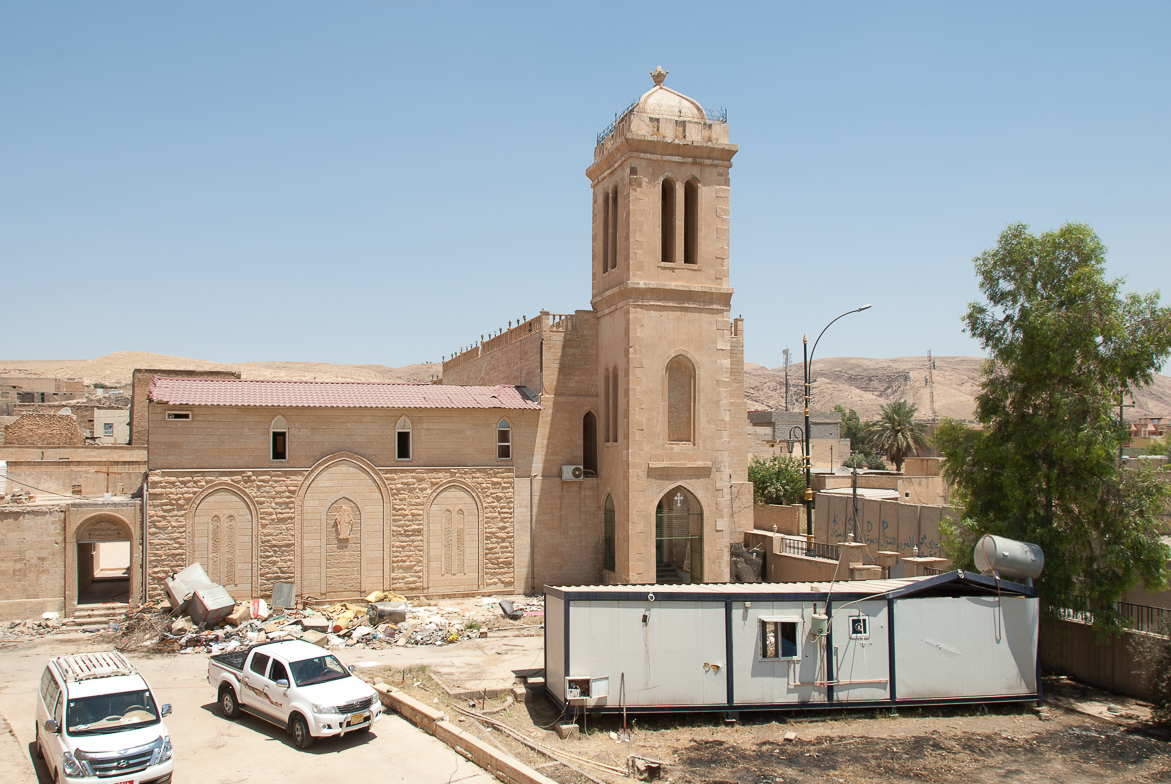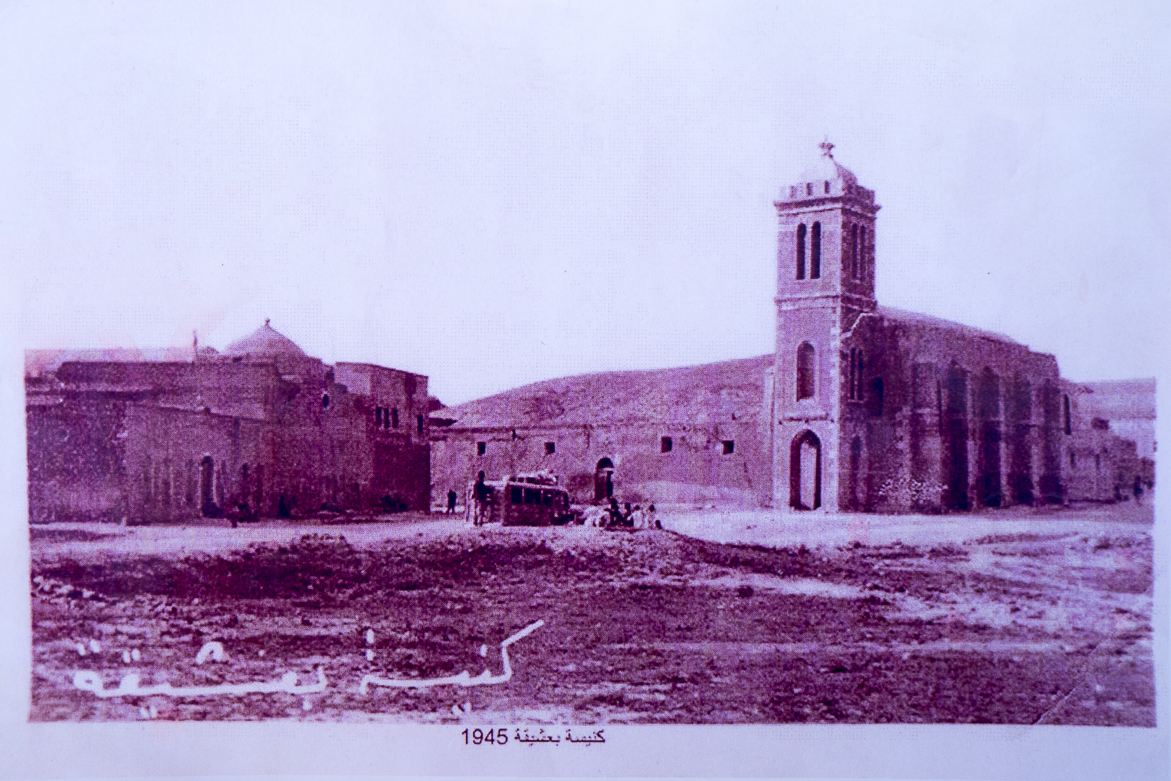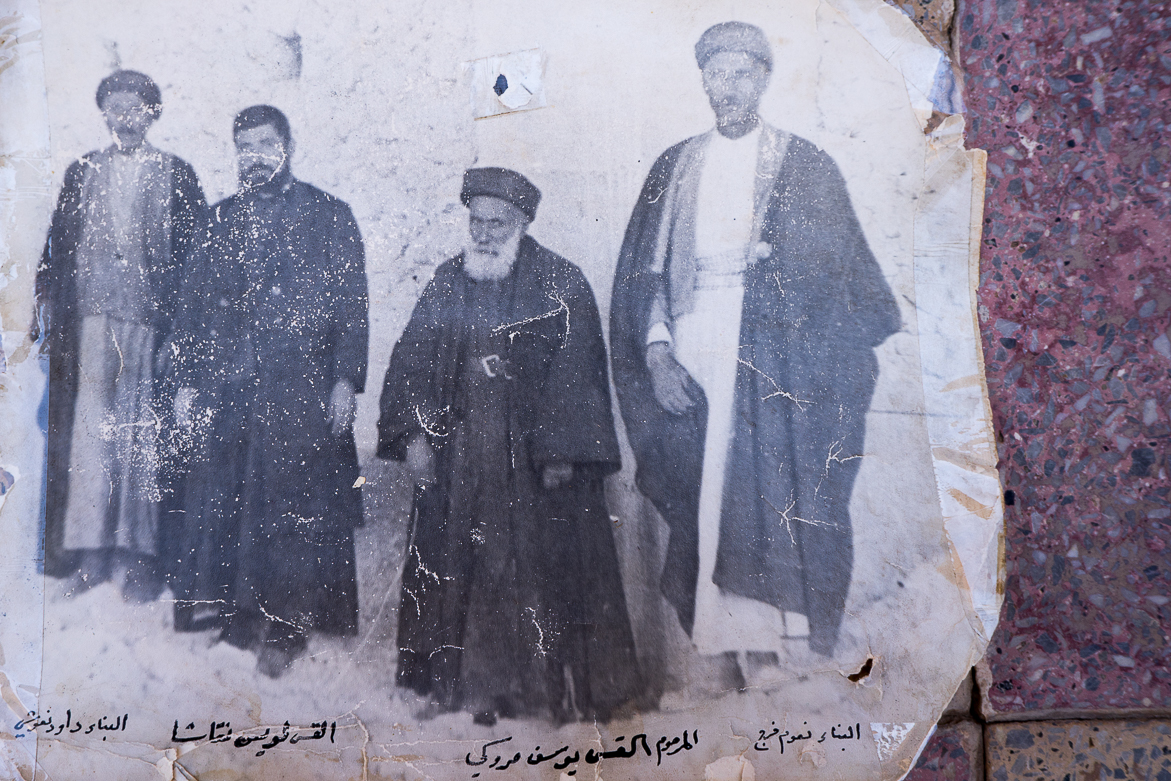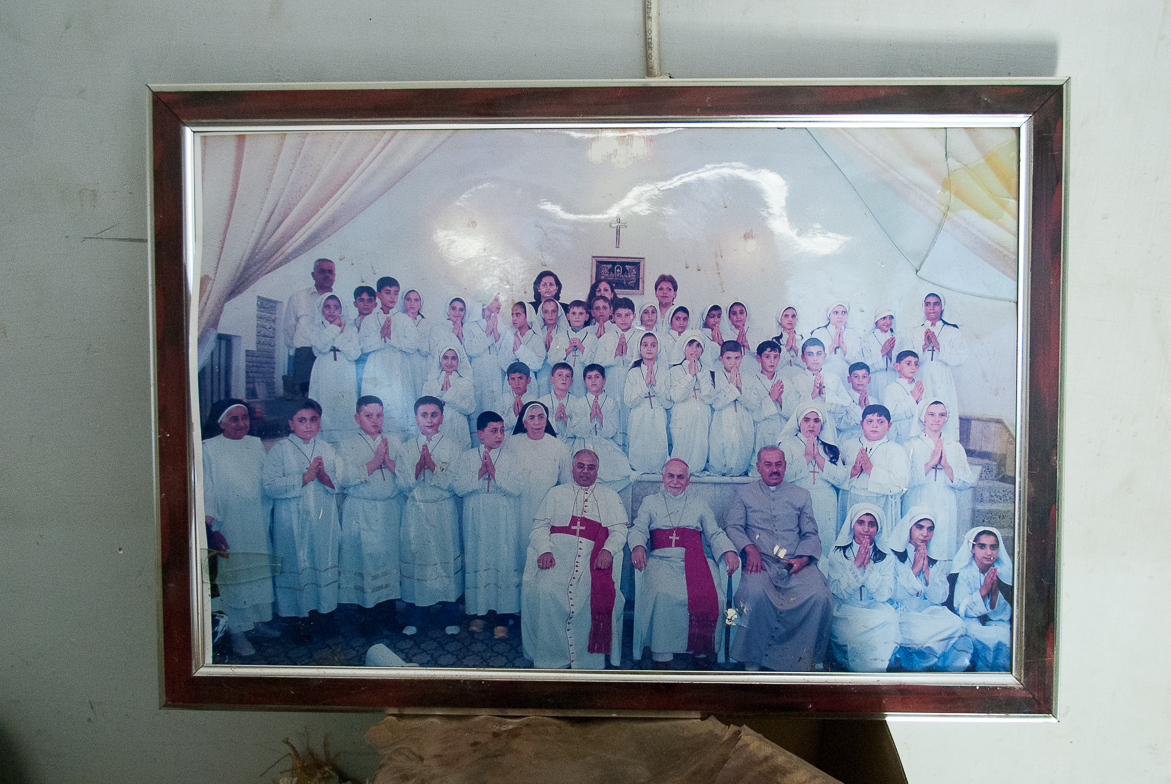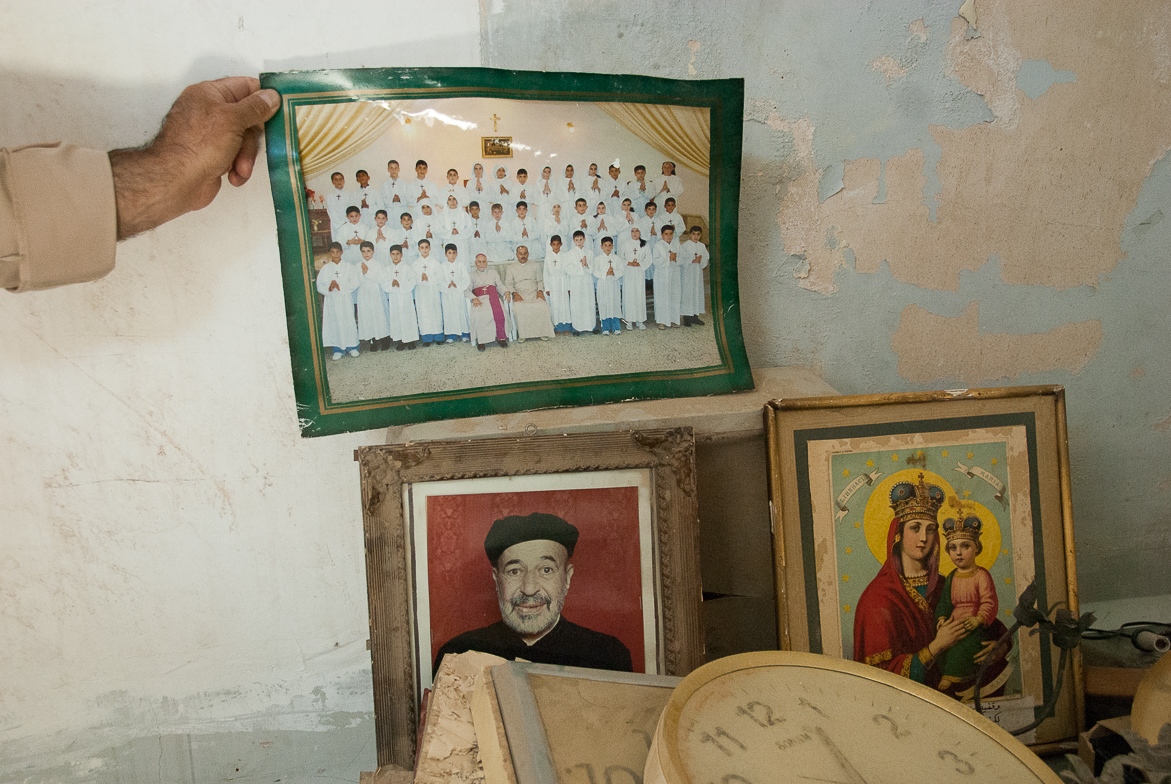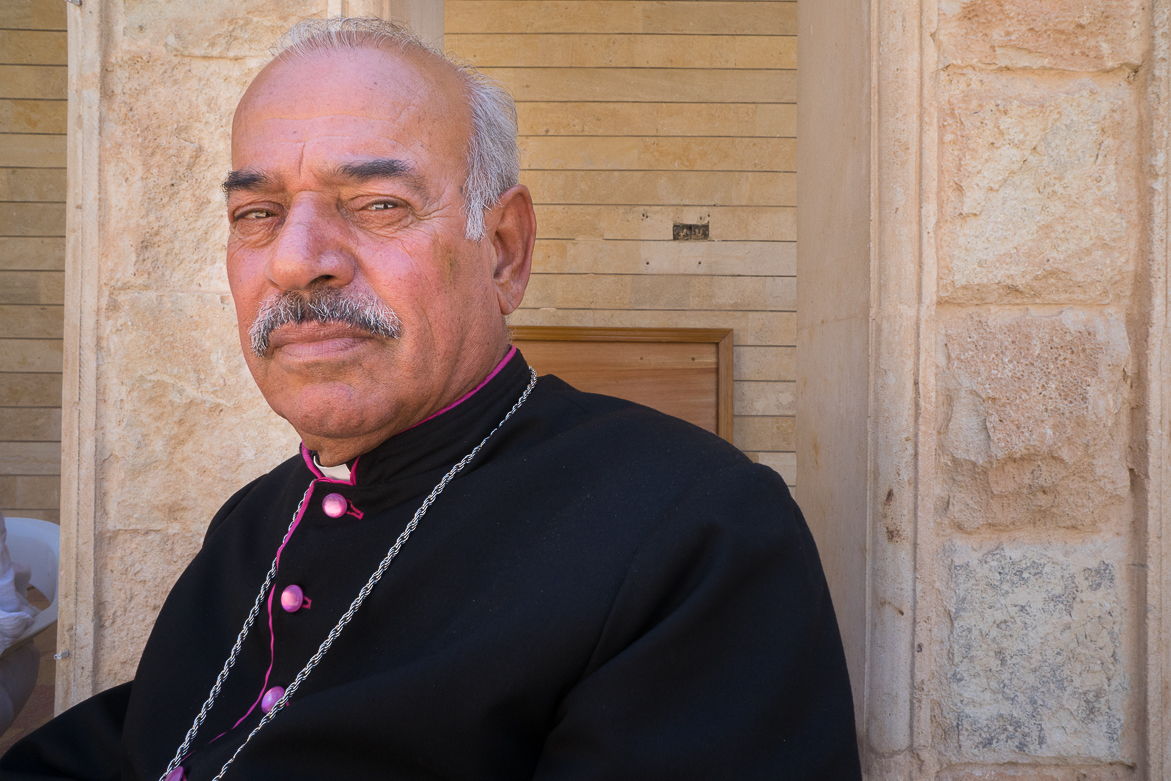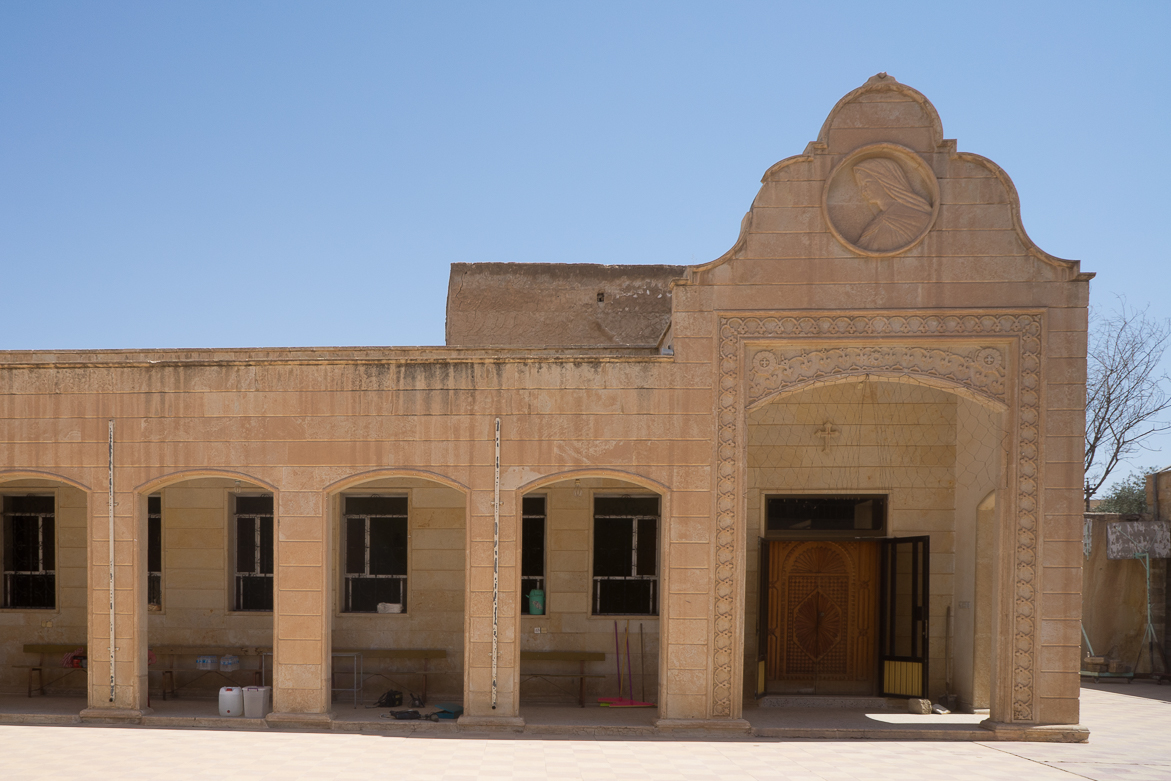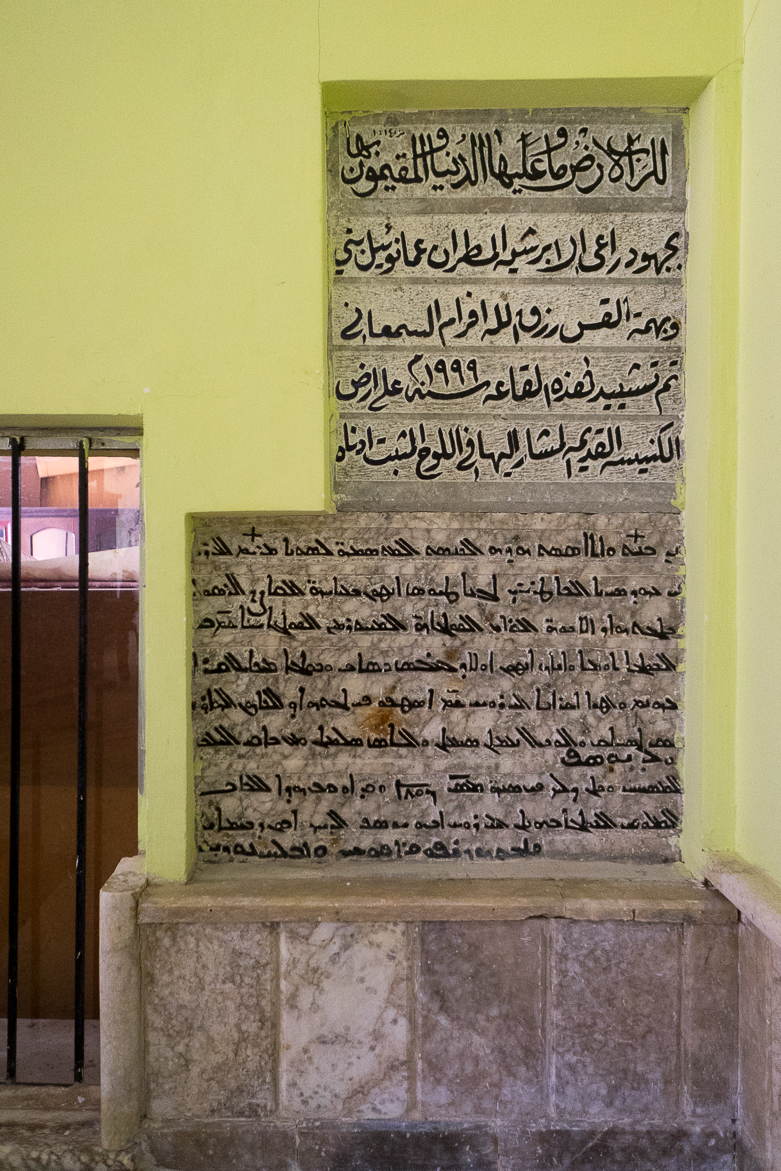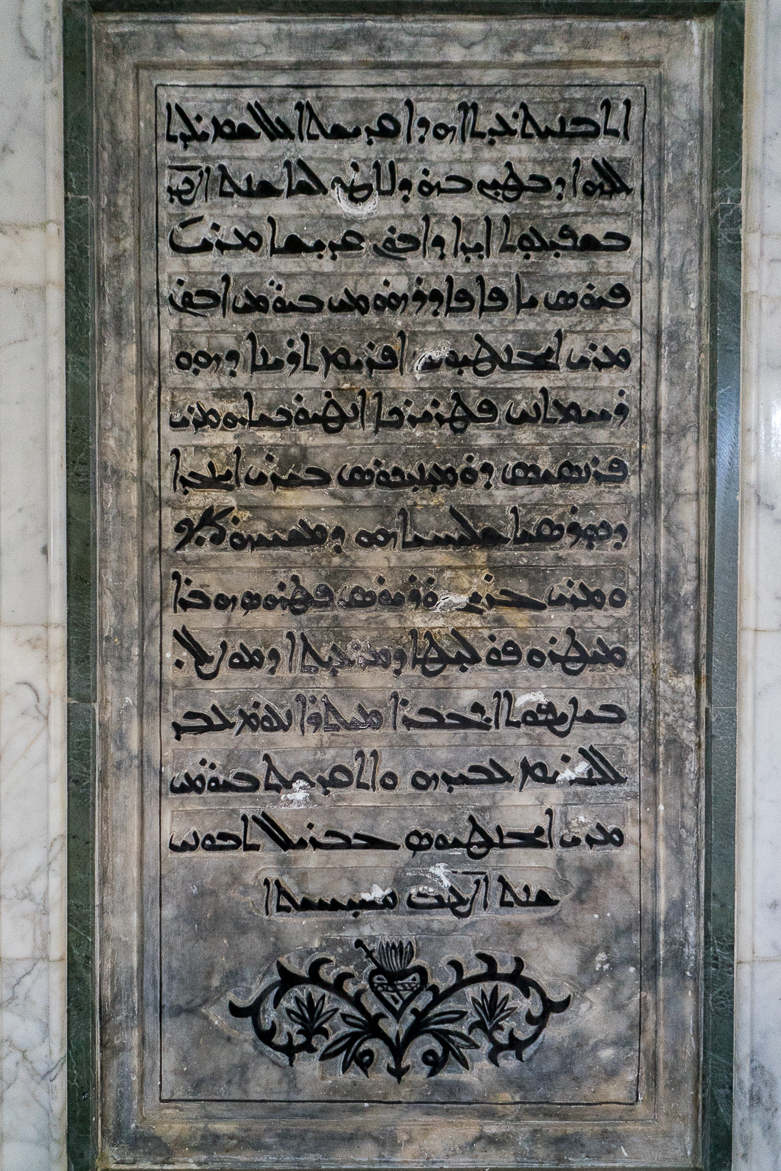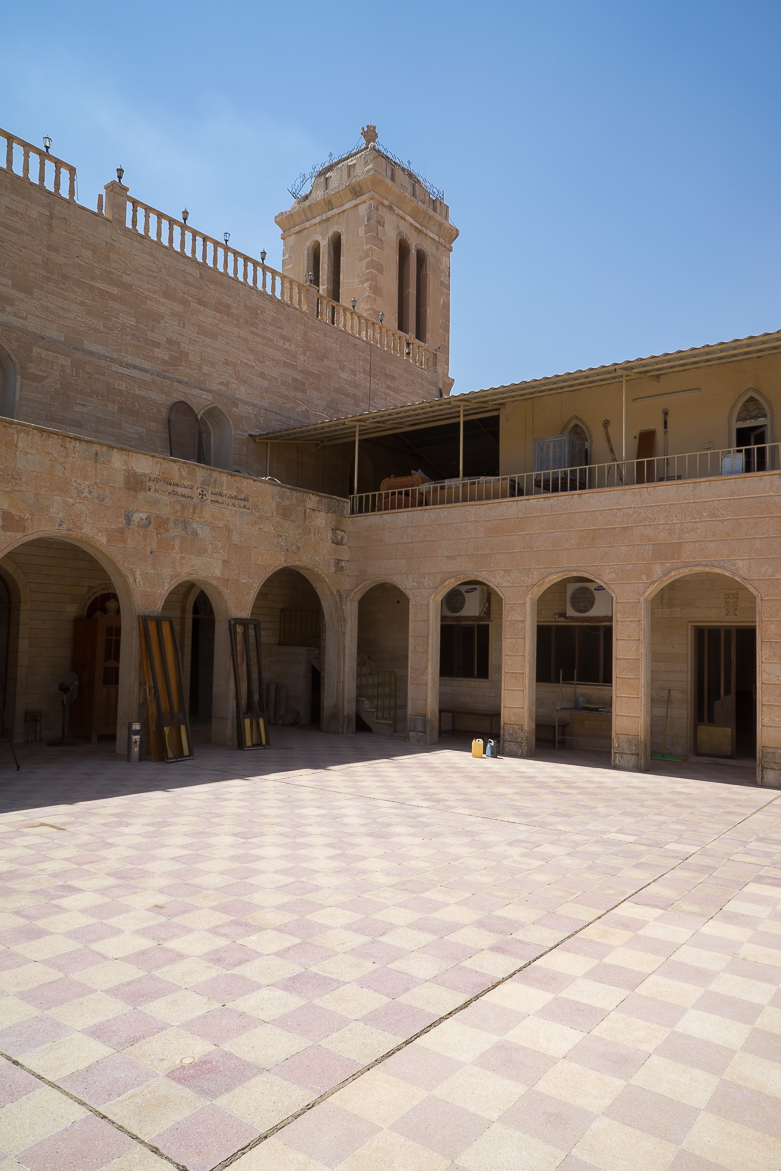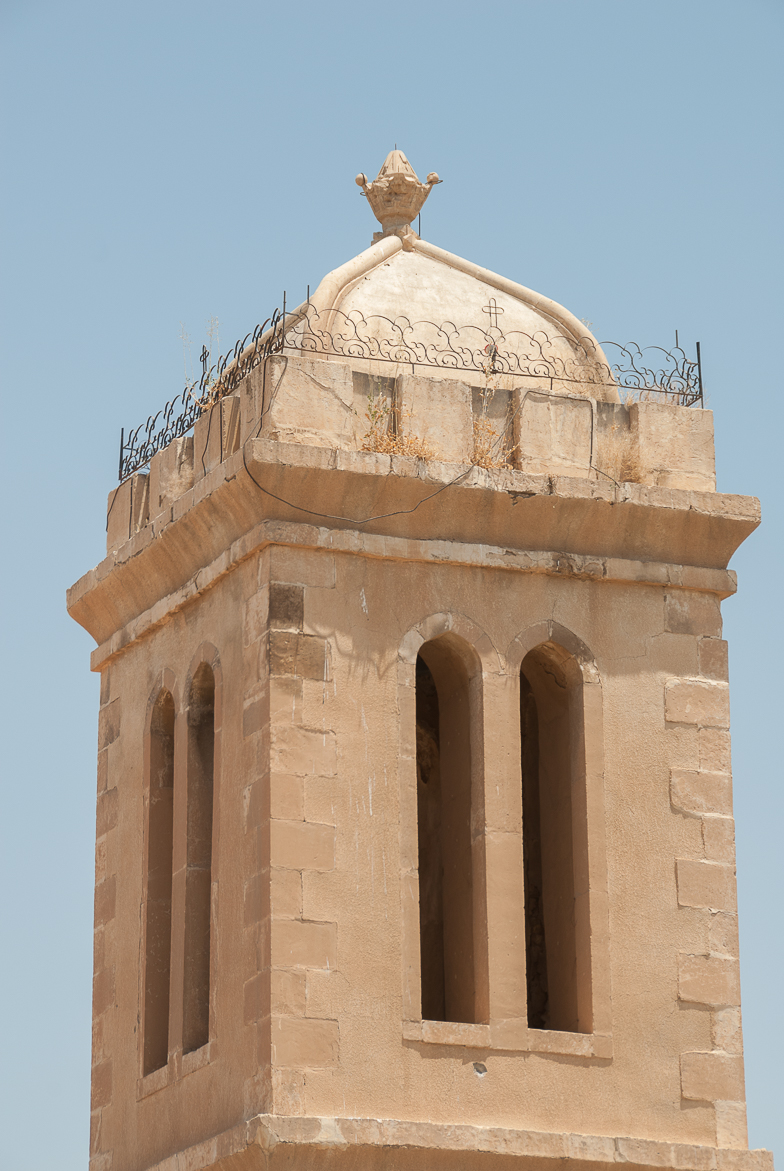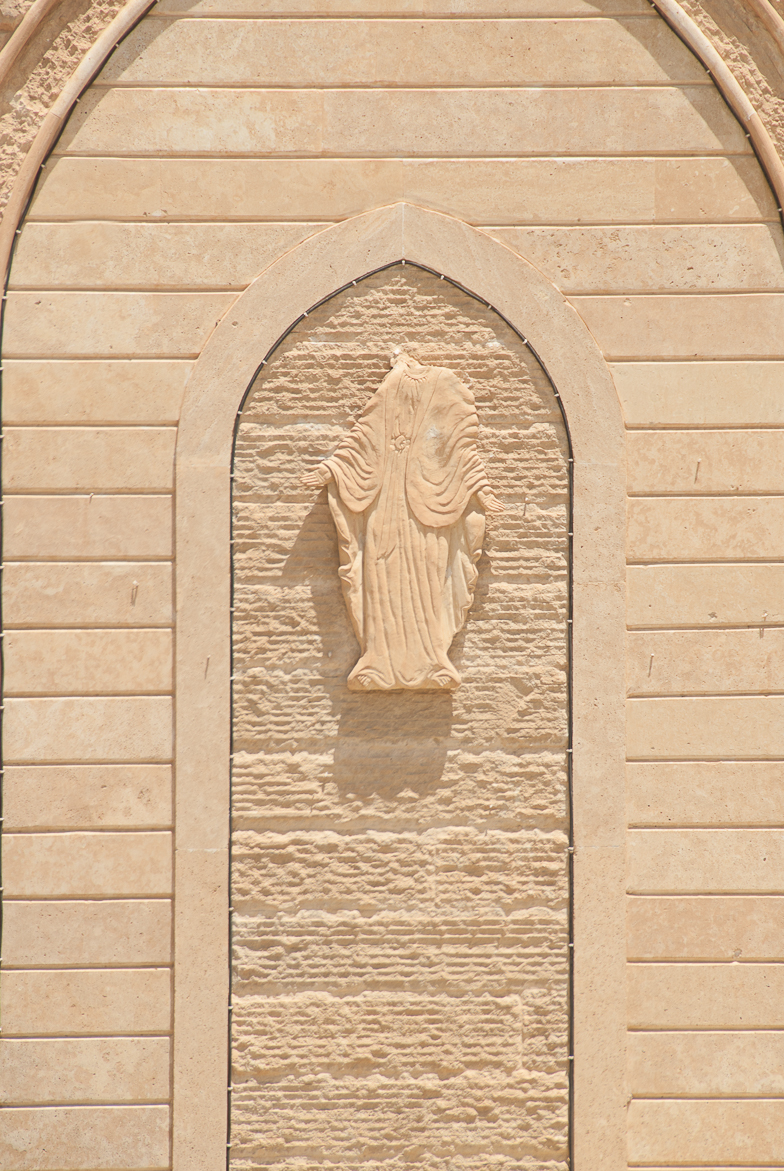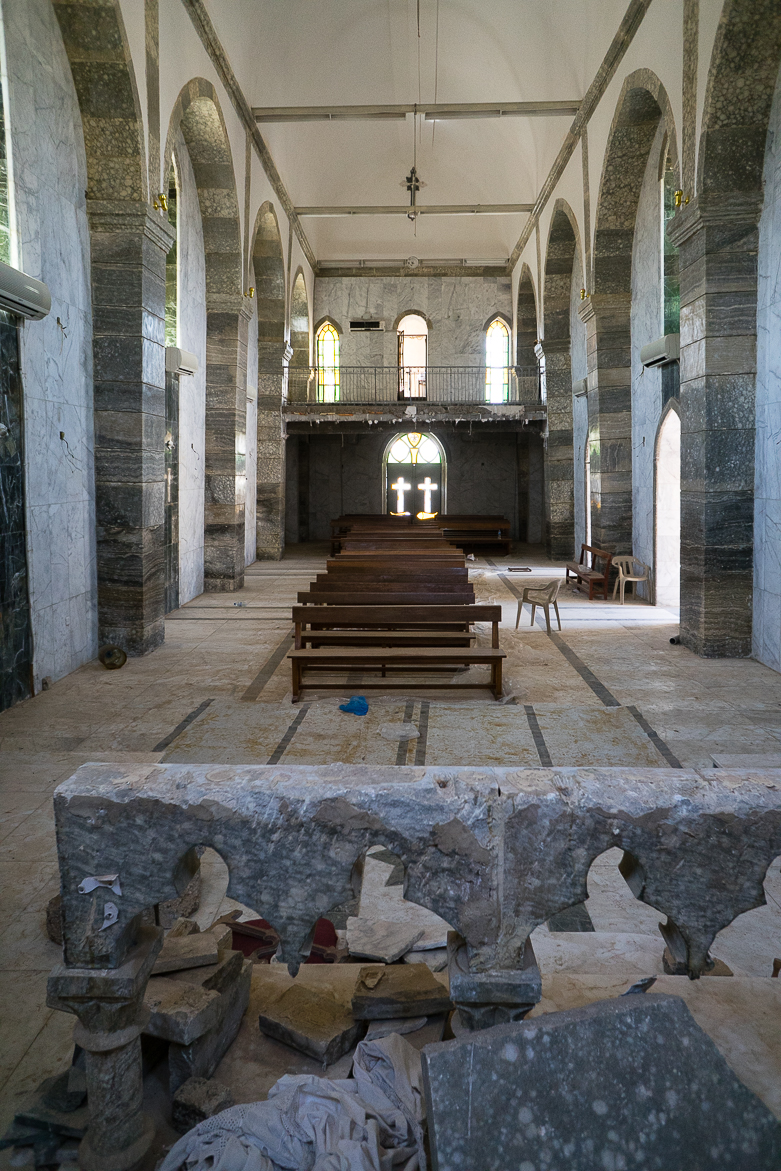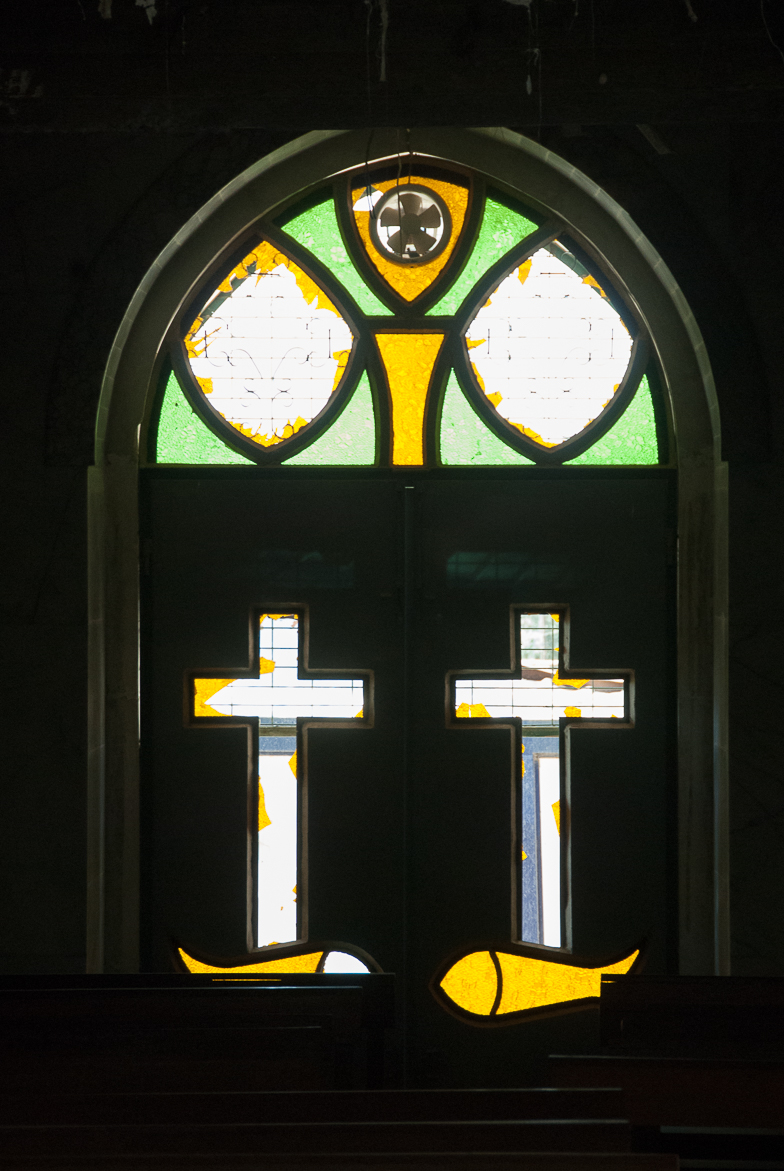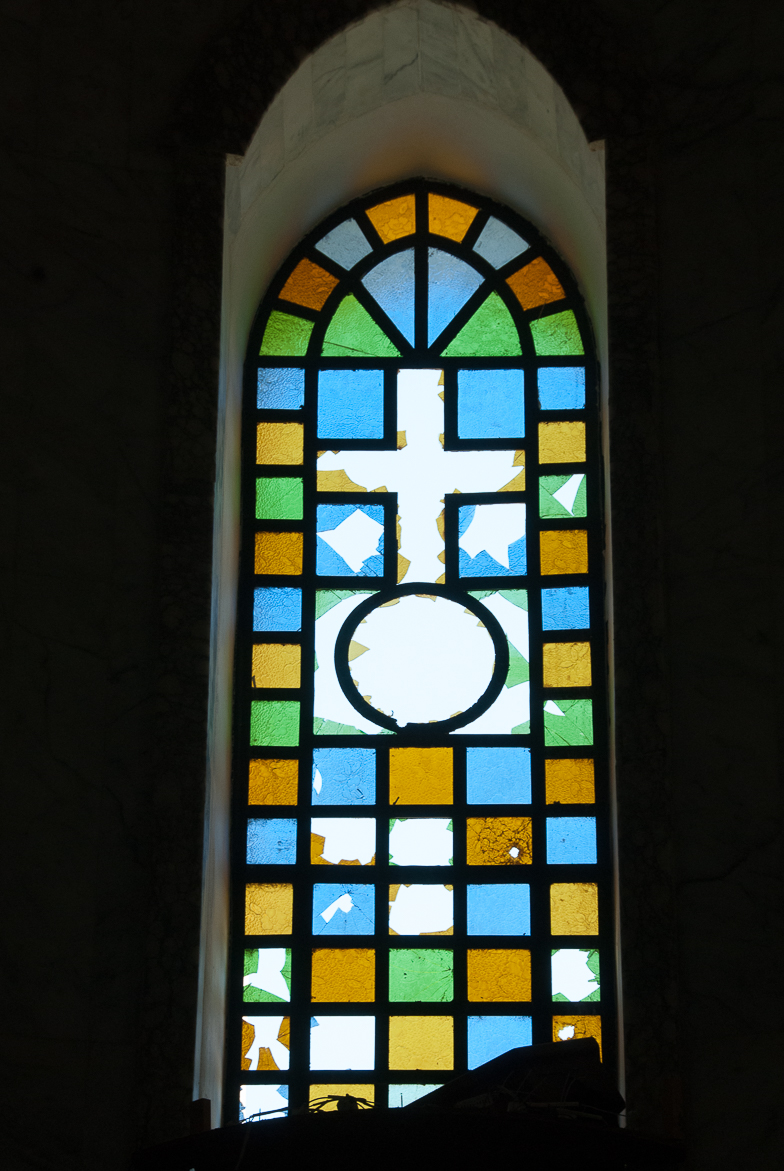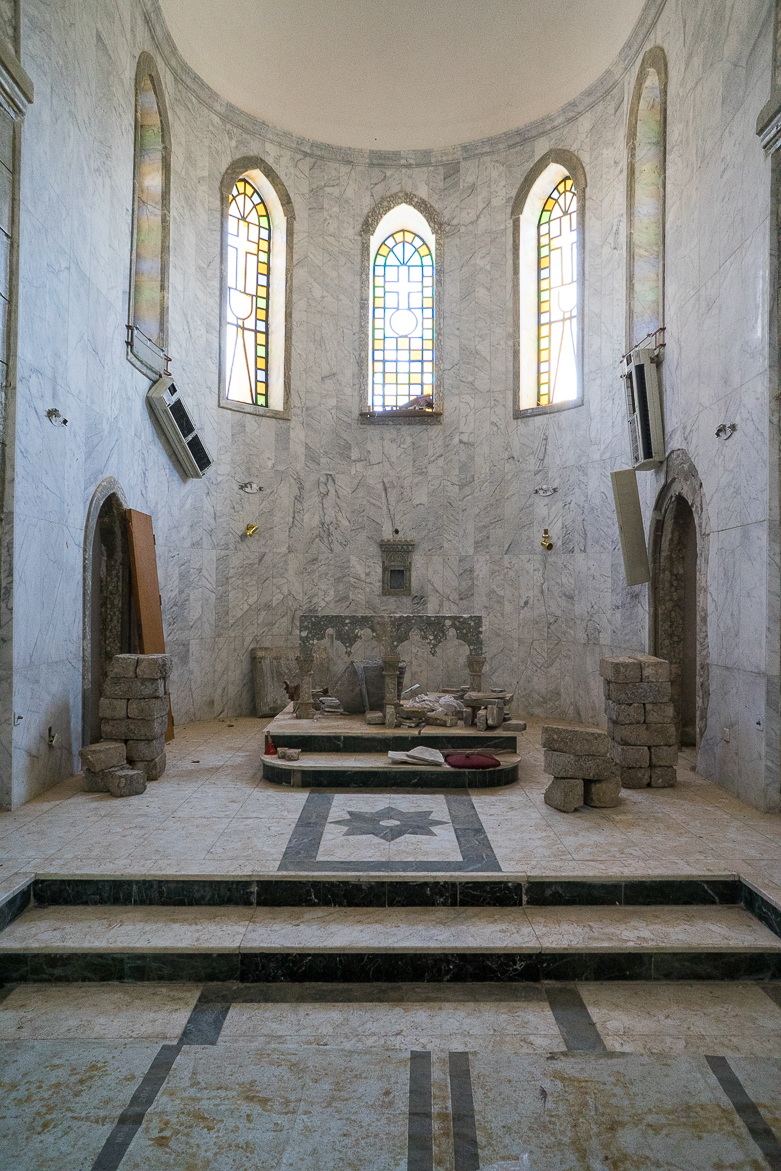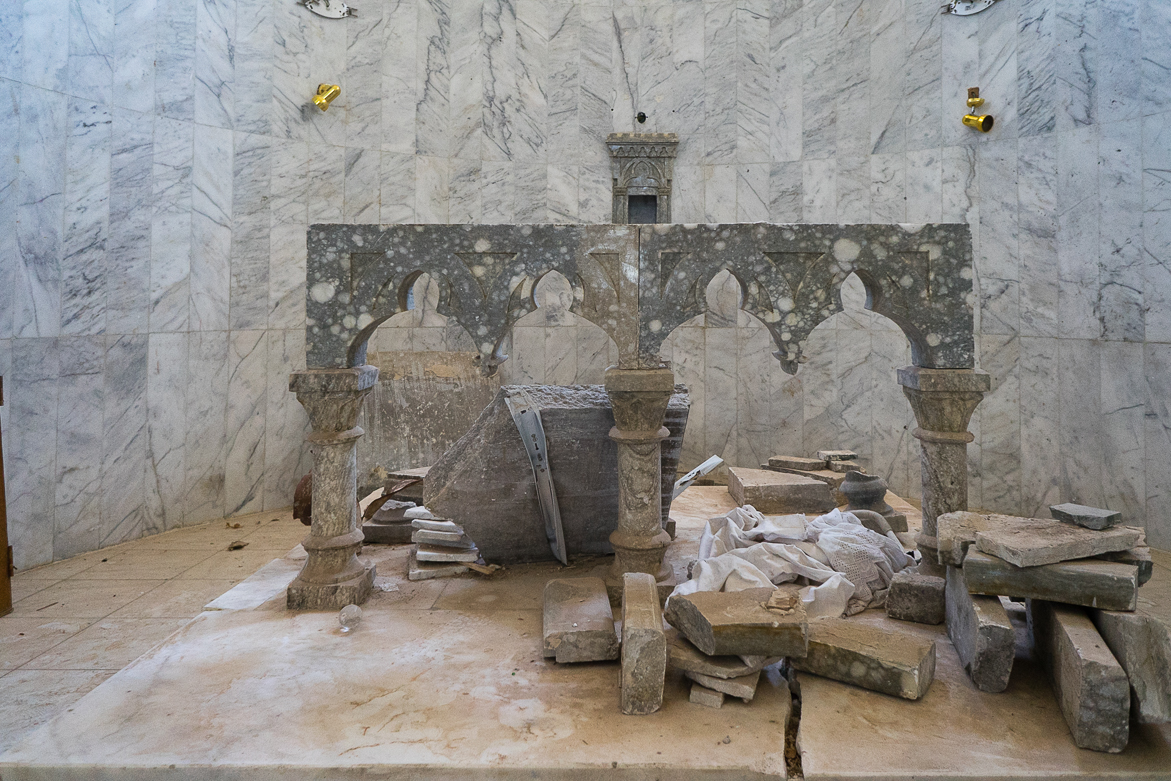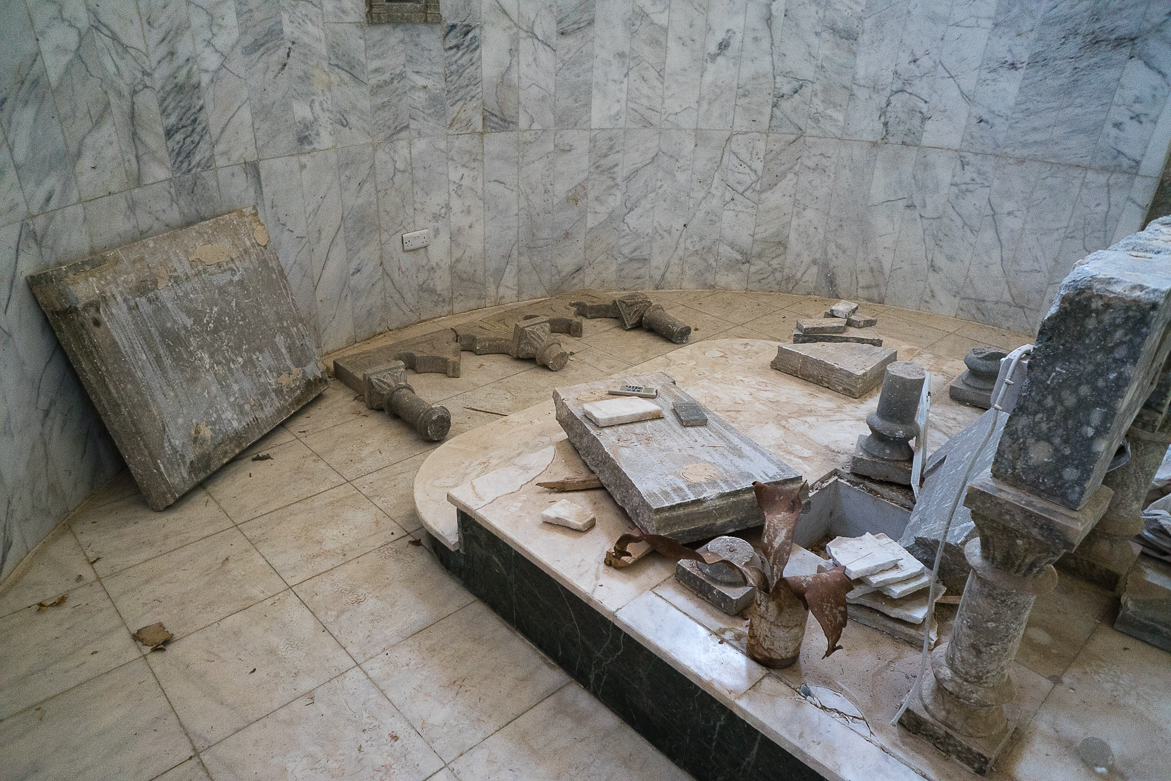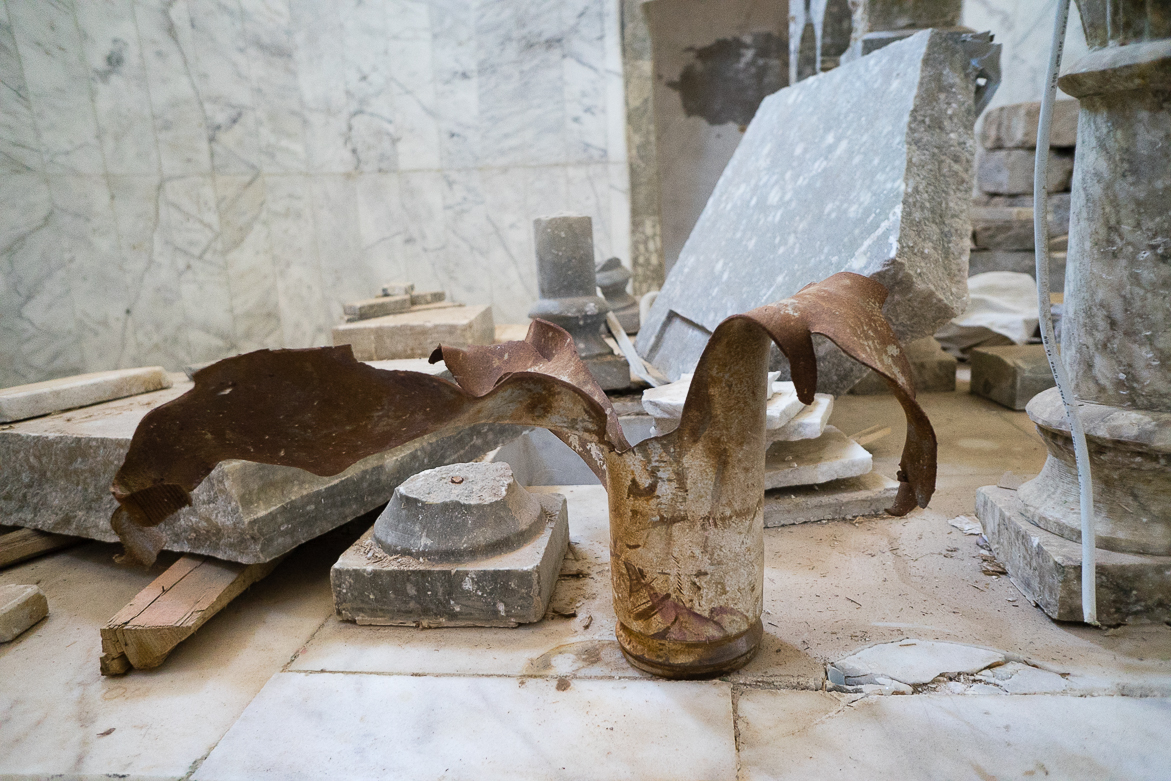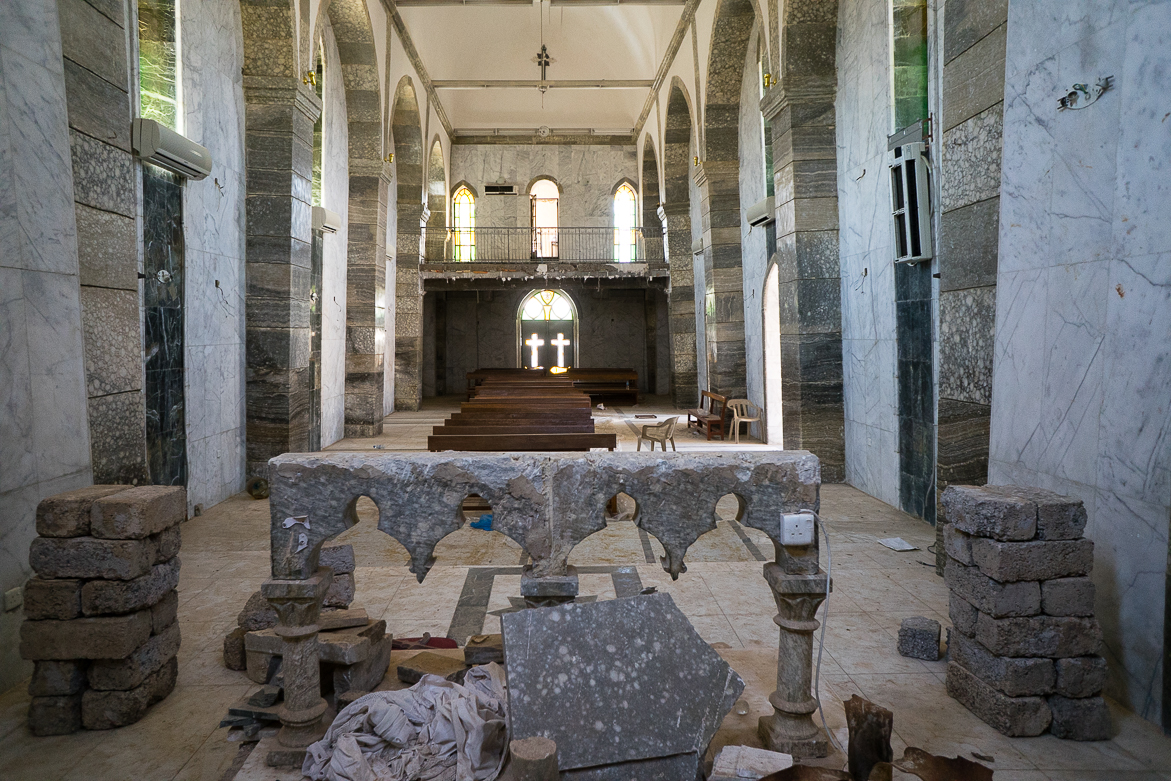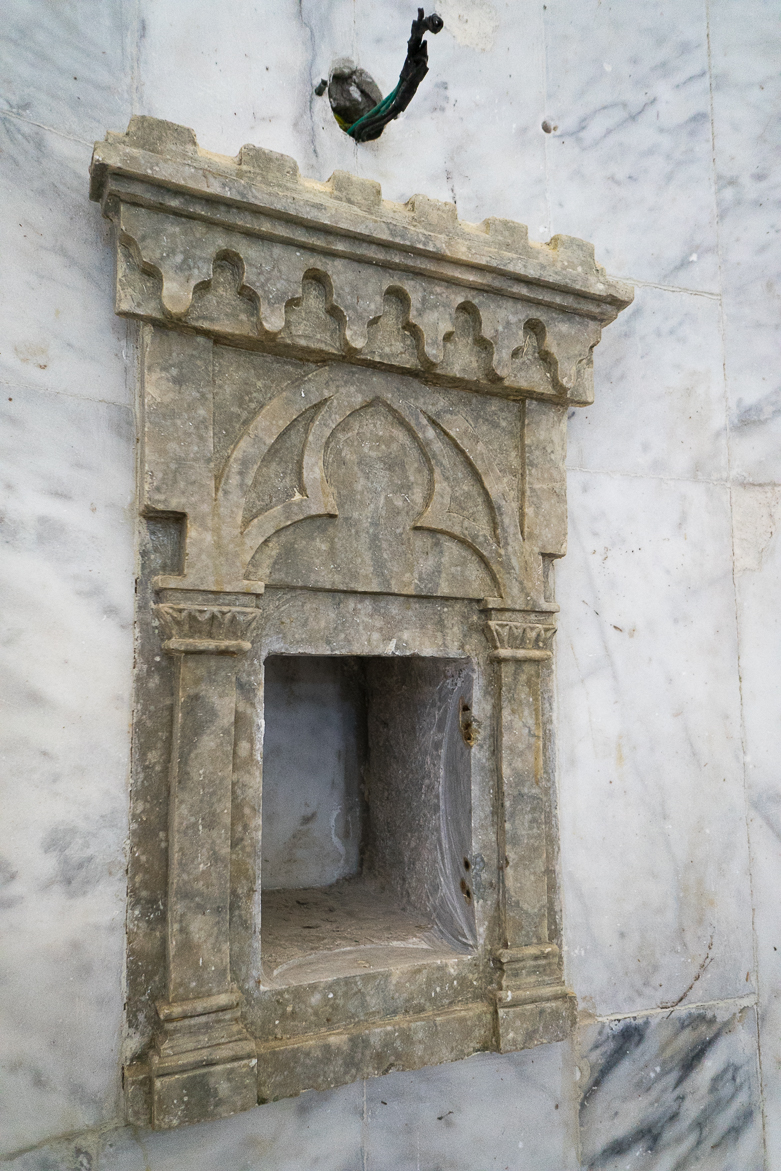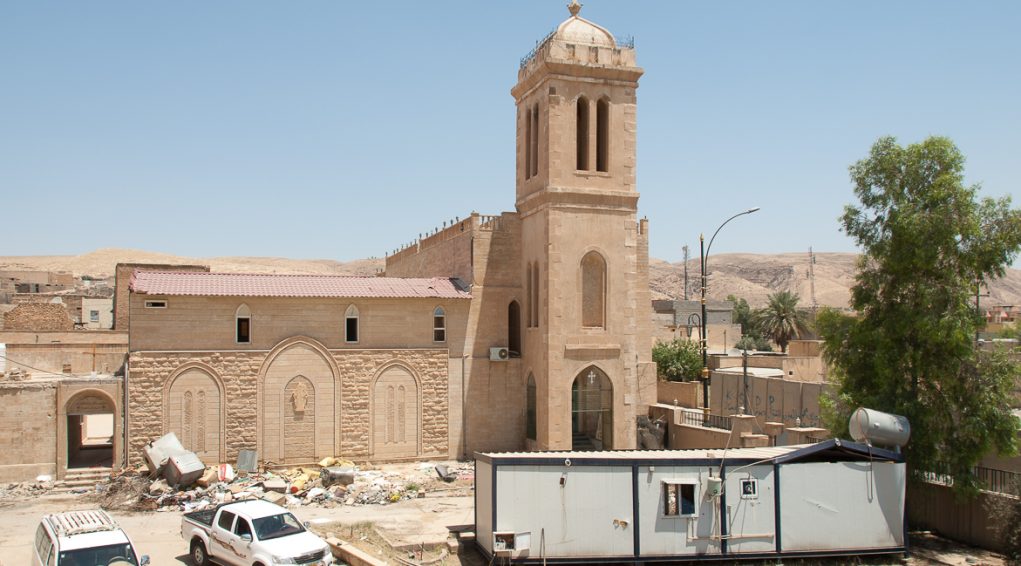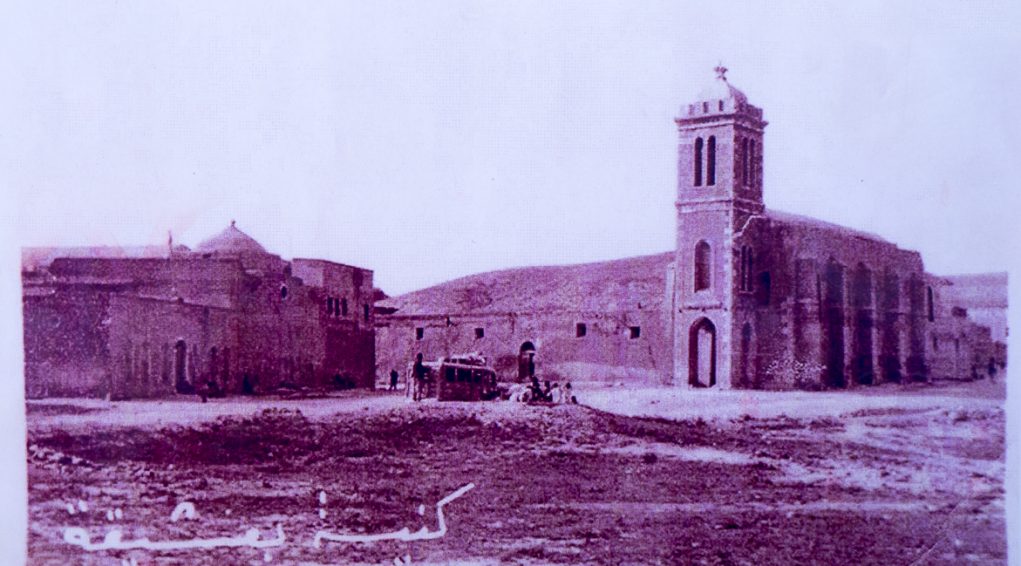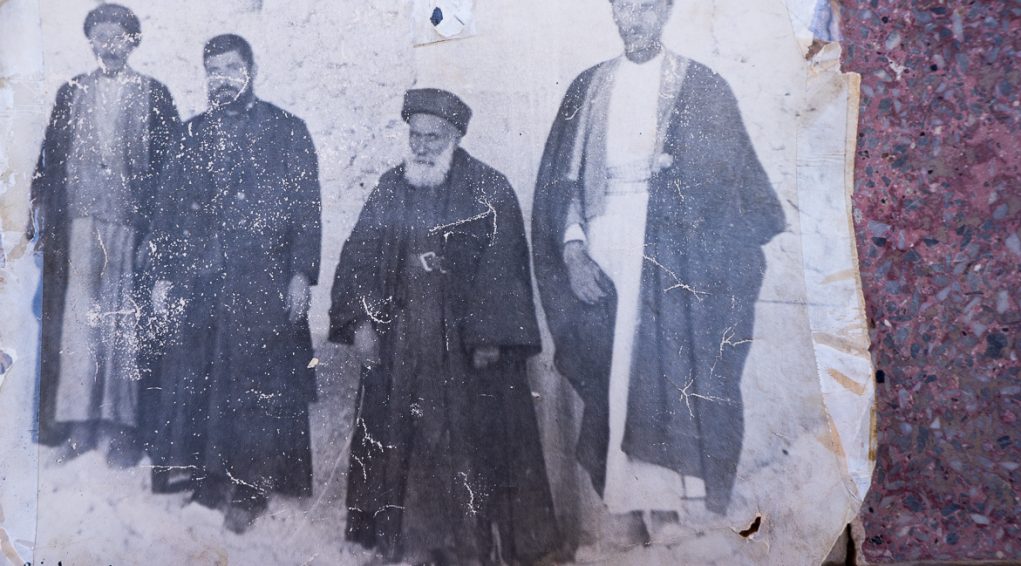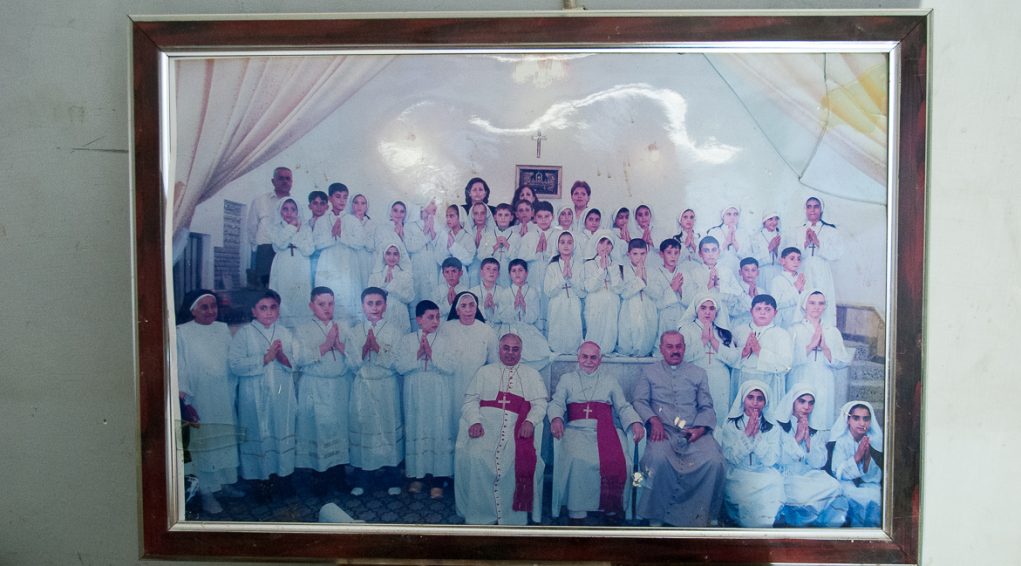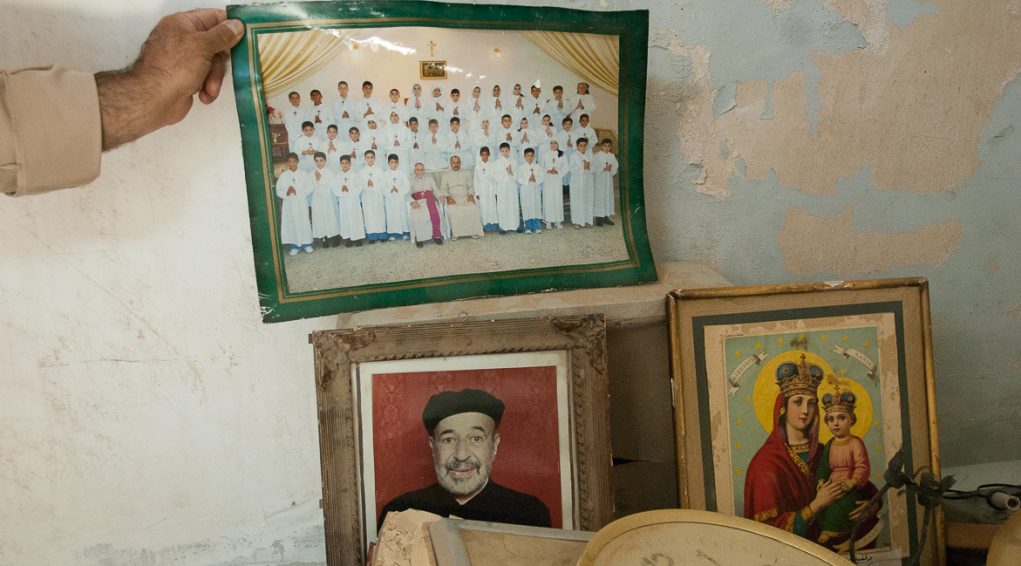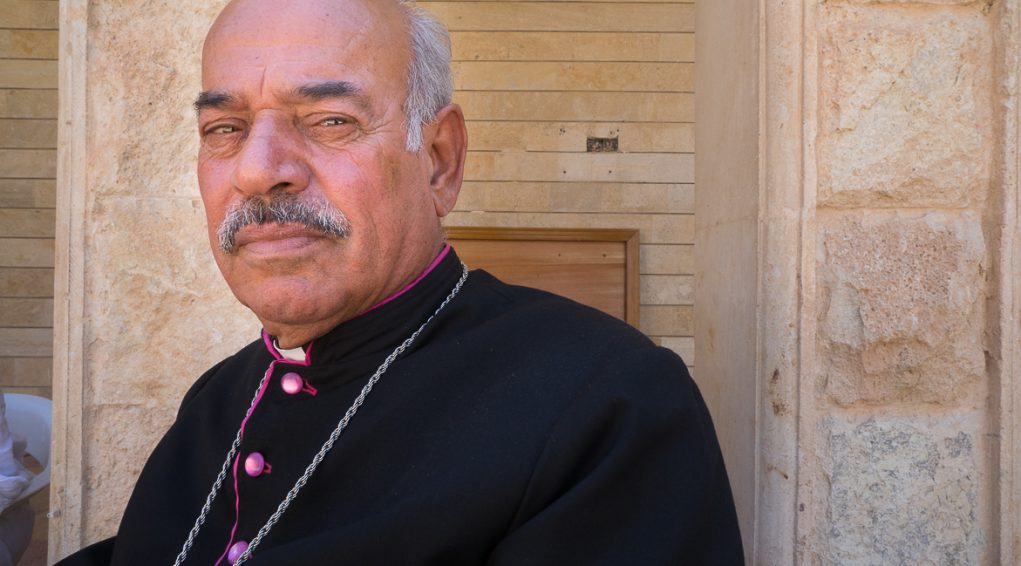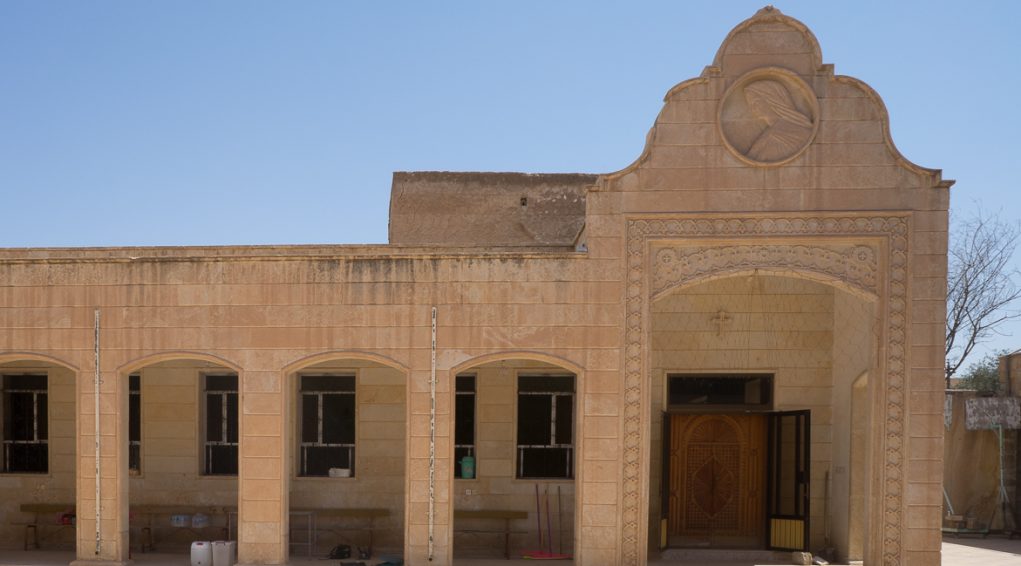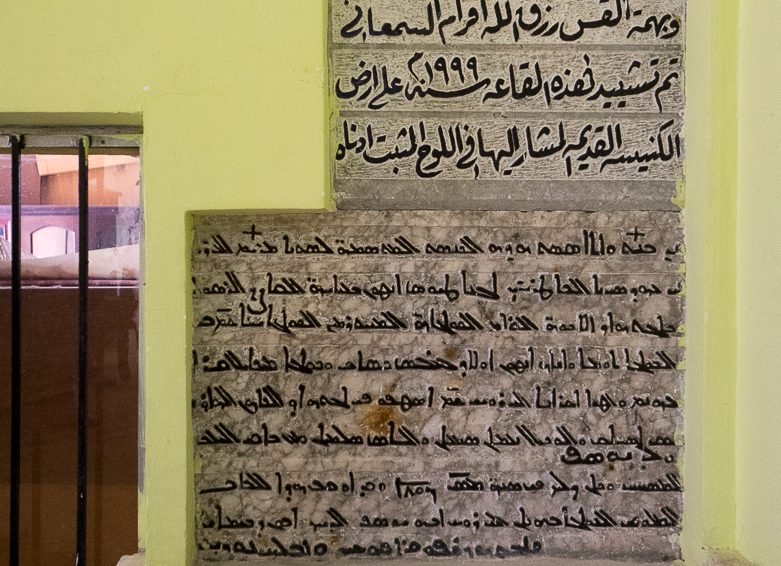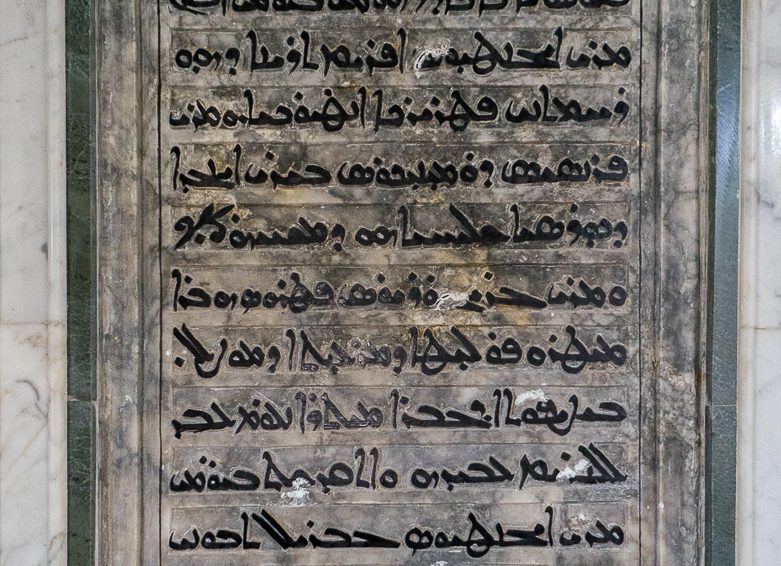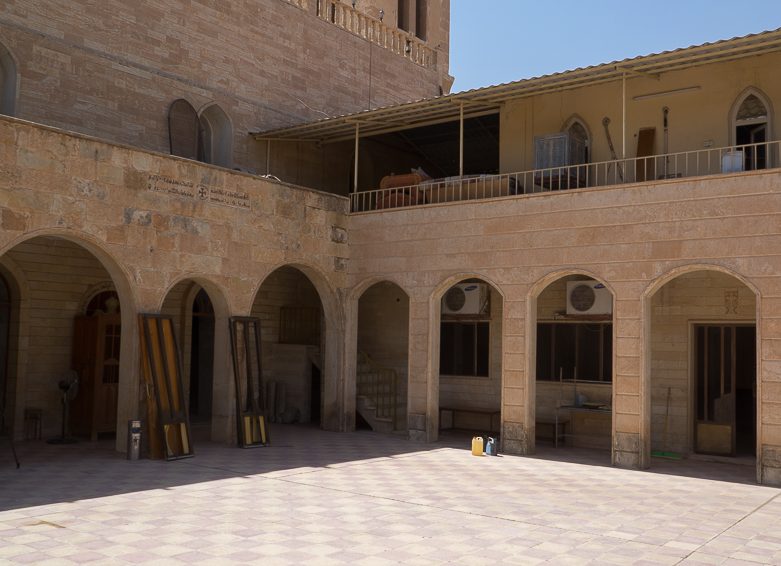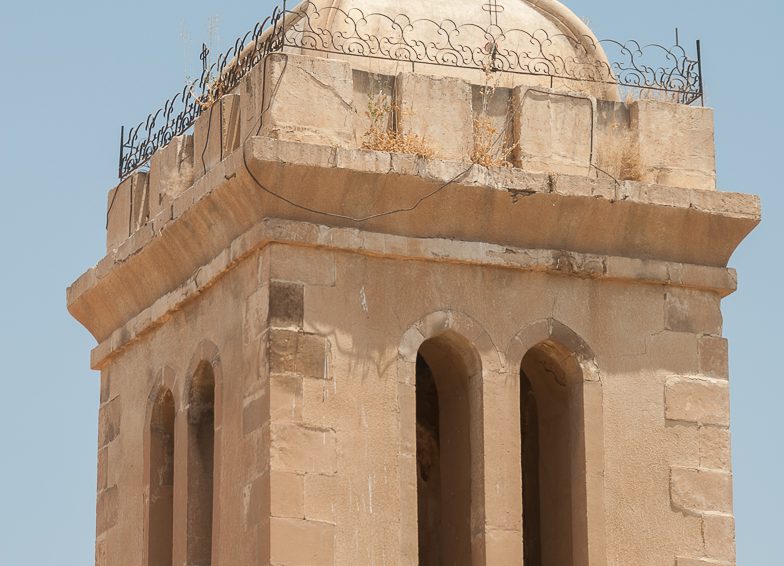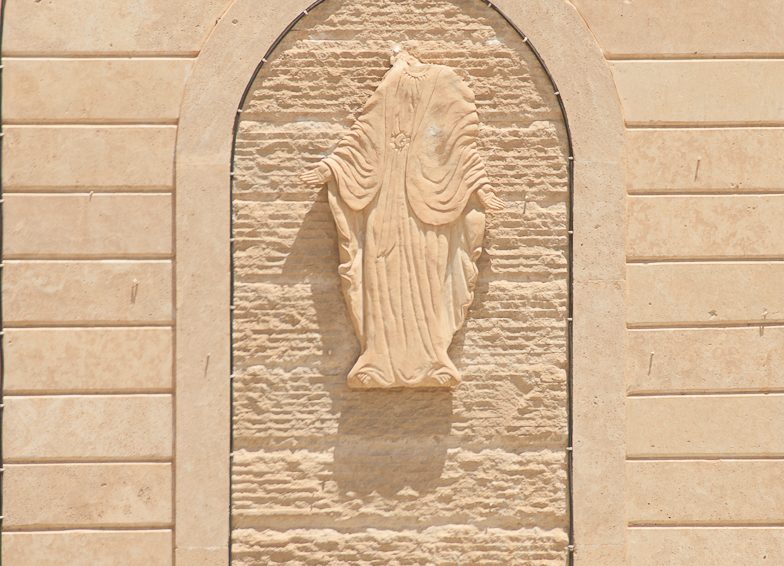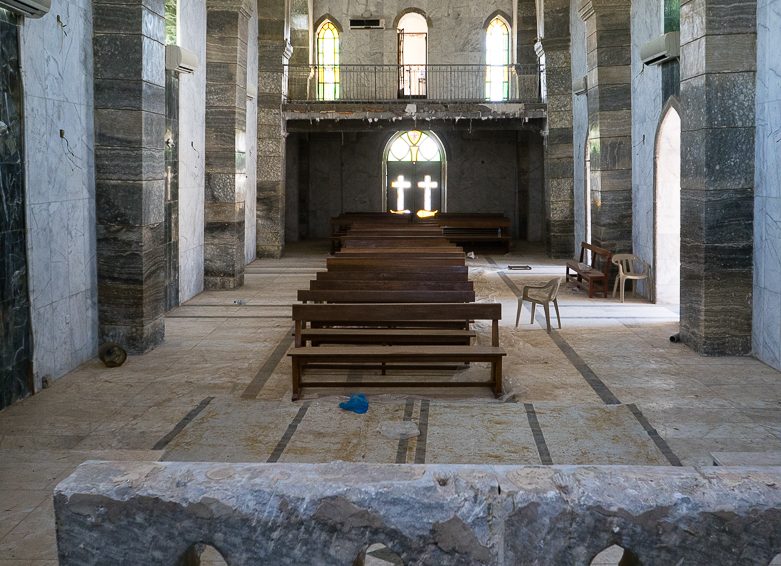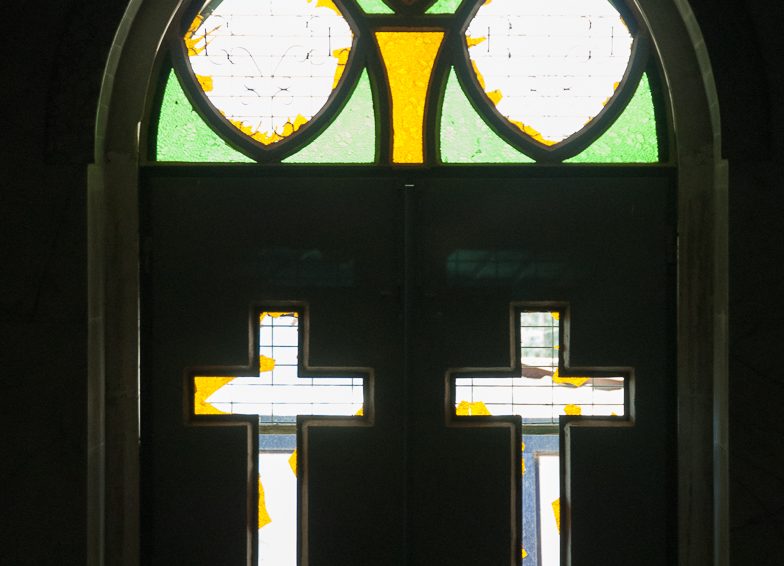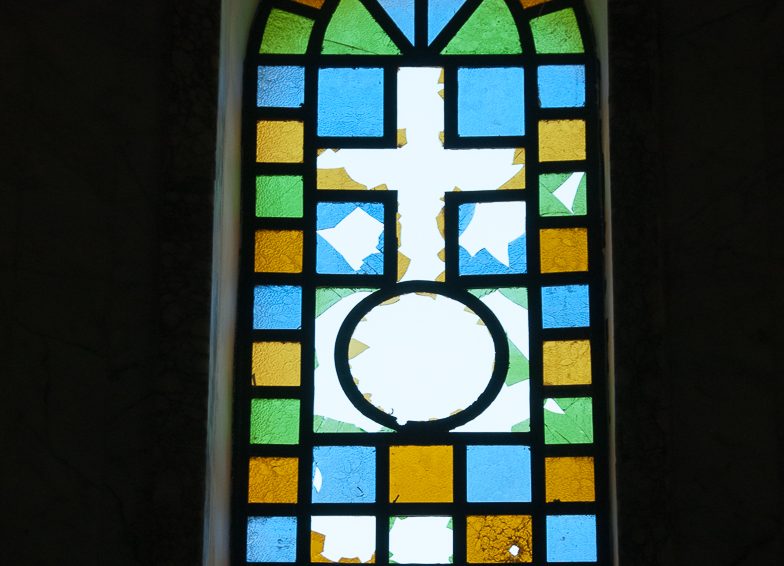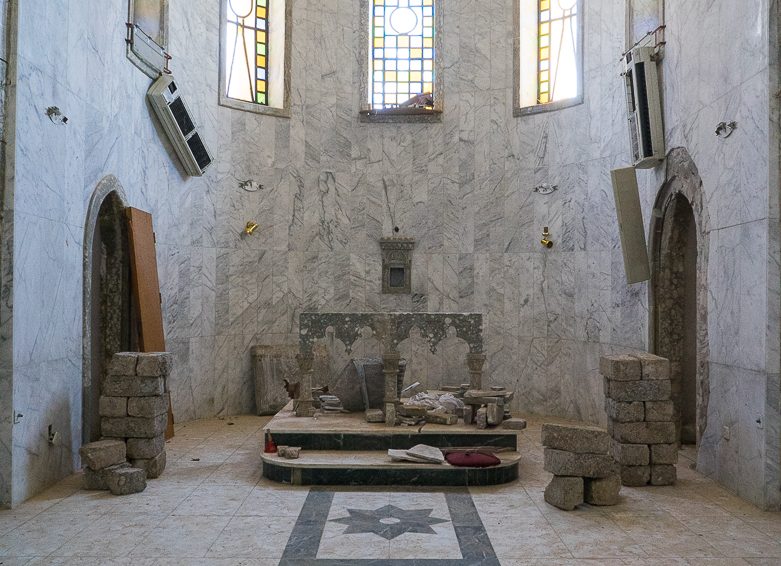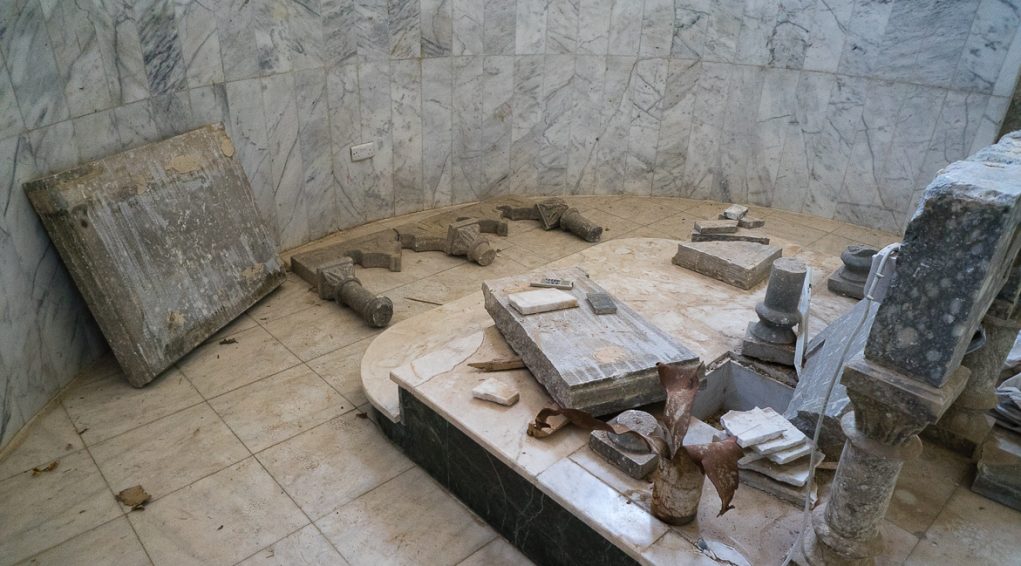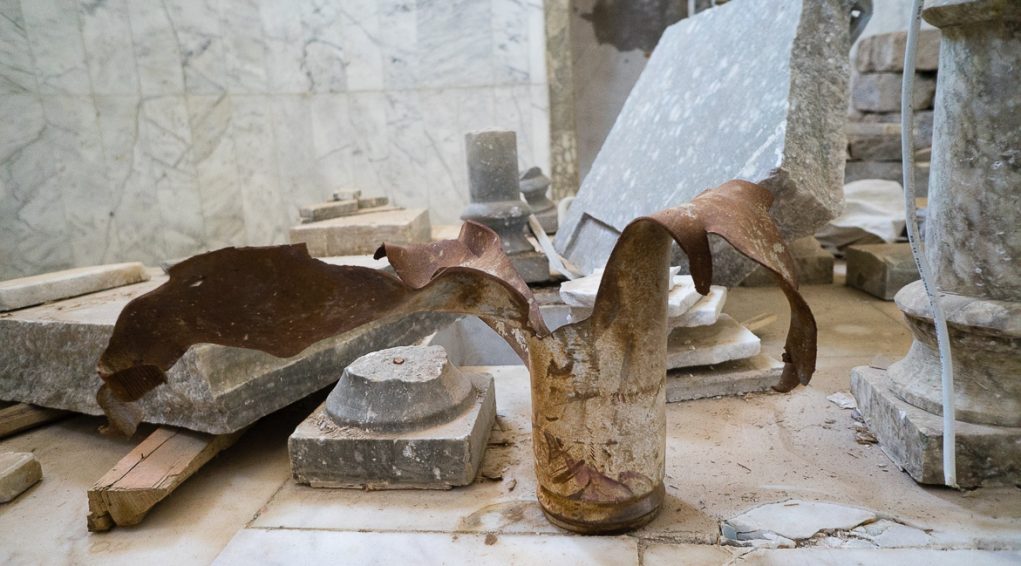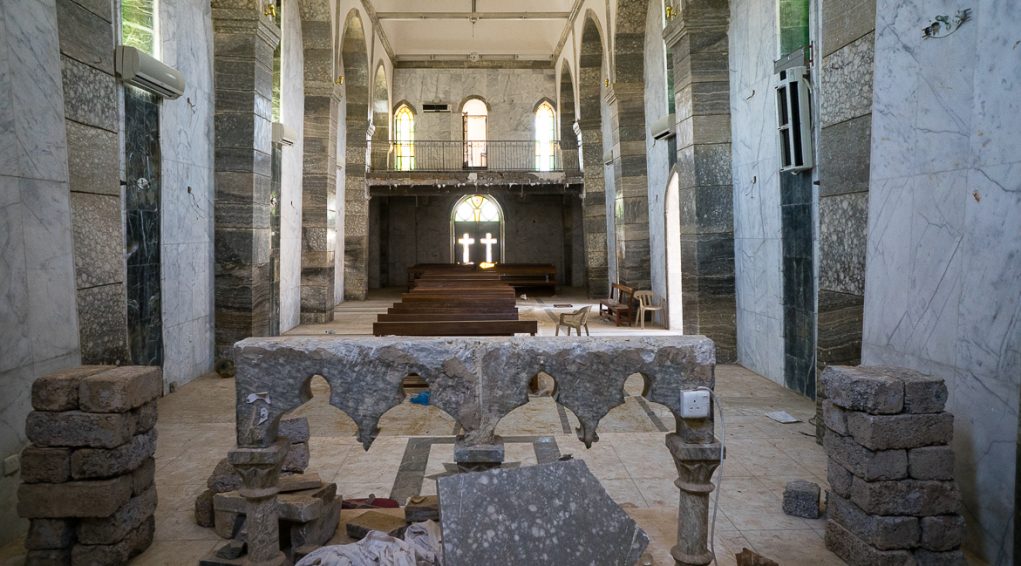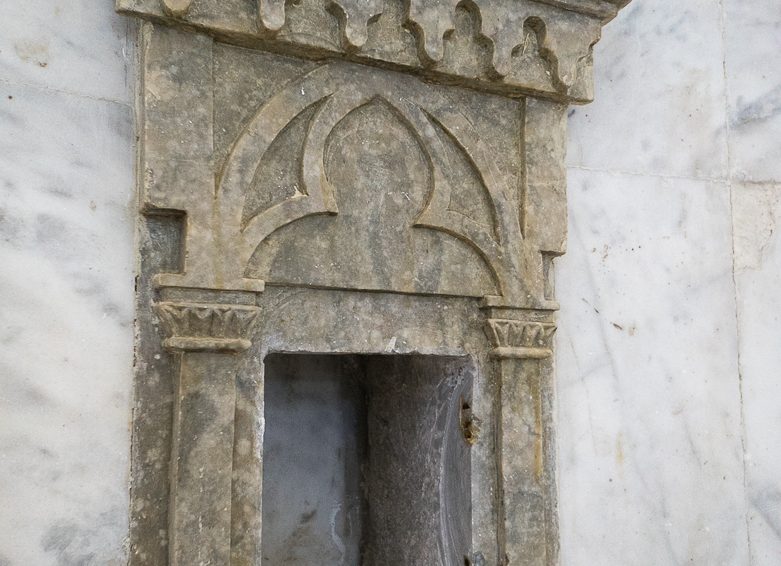Mart Mariam al Adra Church in Baashiqa
The Syriac Catholic church Mart Mariam al Adra in Baashiqa lies at 36°27′.04.9”N 43°20′.56.3”E and 343 metres high.
The church was profaned during ISIS occupation of the town in 2016.
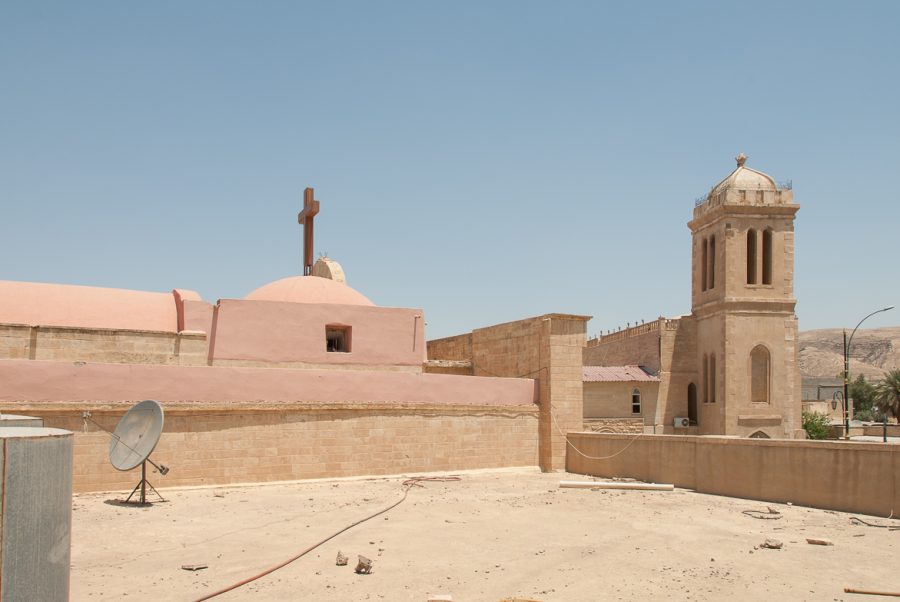
The old church of Mart Mariam al Adra had been built in the 19th century, as confirmed by an inscription from 1856 engraved on a stone. This church had eventually been destroyed. The new Mart Mariam al Adra church was built between 1924 and 1932, as can be read inside on a plate.
From the outside, it shows an elegant style. The church has a single, narrow and slender nave, with a flat roof with balustrades atop. On the western side, a lovely bell tower adorns the façade.
Location
The Syriac-Catholic church Mart Mariam al Adra in Baashiqa[1]lies at 36°27′.04.9”N 43°20′.56.3”E and 343 metres high, 21 km north-east from Mosul, 10 km north from Bartella, 30 km north from Baghdede (Qaraqosh) and 60 km north of the confluence of the Tigris River (on the west) and the Great Zab (on the east).
This is the very heart of Mesopotamia, the Syriacs’ plains. This area bears the marks of its both Syriac-Orthodox and Syriac-Catholic denominations. Baashiqa is also one of the largest community centres for Yazidis, on the eastern part of the Tigris River. The city is famous for olive trees, date palms and orange trees growing.
The Syriac-Catholic church of Mart Mariam al Adra is located on the same square and next to the Syriac-Orthodox church of Mart Shmoni. These twin churches can be seen as a symbol and testimony of Christian unity.
[1]Several spellings are used for the same name of the town. In his work “Assyrie chrétienne”, the Dominican scholar, Jean-Maurice Fiey uses the name « Bā‘šīqa ». The Orientalist and geographer vital Cuinet used « Bahchika ». Amir Harrak, expert in Syriac and Aramaic language and literature and Professor from Toronto University uses the name « Ba‘šīqā ». Professor Christian Lochon, great Arabic-speaking Orientalist writes “Bachiqa”. For this notice, we chose “Baashiqa” in order to emphasize the pronunciation of the double “a”.
Fragments of past and present history
According to the tradition, Christianity entered the Nineveh plain and the city of Baghdede(Qaraqosh) at as early as the end of the 4thcentury or beginning of the 5thcentury. More surely, sources claim for an evangelization at the 7thcentury.
The geographer Vital Cuinet censed there 3000 inhabitants at the end of the 19th century: 2000 Christians and 1000 Yazidis[1]. During the 20thcentury, there used to be “2566 inhabitants, split as such: 1517 were Yazidis, 258 Muslims, and 791 Christians. Among those last ones, 3/5 was Jacobite [Syriac-Orthodox] and the rest was Syriac-Catholic[2].” At the beginning of the 21stcentury, before ISIS attacked, Baashiqa was a city with 10 000 inhabitants. Yazidis represented 2/3 of the population[3]. An important Yazidi temple with domes can still be seen in Baashiqa, Saih Muhammad ar Radani temple, where a big community celebration takes place each year, on the first Friday of April.
According to the Christian history of the city, a “famous Jacobite school had been created there around 630[4]”. The school hosted up to 3000 pupils, which reveals the great influence of Syriac-Orthodox tradition in this area, centuries before Catholicism entered and settled in.
The Muslim community has also a little mosque.
The city was attacked by ISIS in December 2015. During ISIS occupation and until it was liberated in November 2016, ISIS fighters profanated, sullied, and wrecked both large churches of the town: the Syriac-Catholic Mart Mariam al Adra, and the Syriac-Orthodox Mar Shmoni.
Since the town has been freed, inhabitants progressively come back and take part to the Syriac and Yazidi renewal in the Nineveh plain and throughout Mesopotamia.
[1]In La Turquie d’Asie, Tome 2, Ernest Leroux éditeur, Paris, 1891.
[2]In Assyrie Chrétienne, JM Fiey, p.461
[3]In Qaraqoche ou la disparition des chrétiens de la plaine de Ninive,Revue de l’Œuvre d’Orient, Christian Lochon, p.137
Description of the church of Mart Mariam al Adra
There used to be in Baashiqa an old Syriac-Catholic church dedicated to Mart Mariam al Adra (the Virgin Mary) before a new one bearing the very same name was built in 1924-1932. This is not rare in Iraq but can lead to some confusion.
The old church of Mart Mariam al Adra had been built in the 19th century, under the Patriarch Antun Samhērī (1852-1864), as confirmed by an inscription from 1856[1]engraved on a stone. This church had eventually been destroyed. It has been replaced by a new multipurpose building, including a reception room, meeting and prayers rooms. As a vestige of the past, the 81 cm x 54 cm stone with the 9-lines inscription from 1856 has been kept and transferred, embedded in the wall of the new church of Mart Mariam al Adra and can still be seen nowadays.
The new Mart Mariam al Adra church was built between 1924 and 1932, as can be read inside on an engraved plate, embedded in the masonry inside the church. This 14-lines inscription in Syriac language remembers the building and the consecration under the Gabriēl Tappūnī’sPatriarchate, in the year 1932 of the Christ.[2]” The inscription says “This holy church of the Lord’s Mother, the Immaculate Conception, has been built in the year 1924 thanks to the our Holy Father Pius XI, Pope of Roma (…). It has been consecrated under Mar Ignatius Gabriēl Tappūnī, in the year 1932 of the Christ. »
To access the church, you need to get through the entrance gate, on the western side of the surrounding wall protecting the religious compound. The multipurpose room is at the end of the paved courtyard, just where the old church of Mart Mariam al Adra used to stand.
The new Mart Mariam al Adra stands on the southern side of the courtyard. From the outside, it presents an elegant style. The church is a basilica and has a single, narrow and slender nave, with a flat roof with balustrades atop. On the western side, a lovely bell tower adorns the façade, and is just above one of the two main entrances of the church. There is also an entrance on the northern face, but a southern entrance is missing nowadays, although it used to exist in the past.
Inside, the high barrel vault of the nave rests on a structure of marble pillars, all backing onto the walls and exceptionally tilted towards the central axis. At the eastern end of the nave, the chevet consists in a relatively narrow choir, in front of which stands the sanctuary, up on a 2-steps platform. Behind the altar, the rounded apse is lit up by ribbed windows, quite typical of Western religious architecture. The royal gate giving access to the sanctuary is here reduced to a minimum: open on the whole width and almost up to the vault’s top, it consists in a lancet arch.
[1]In Recueil des inscriptions syriaques, Amir Harrak, p.374
The profanation of Mart Mariam al Adra church
In the centre of the sanctuary used to stand before a nice marble altar, with small columns and little multifoil arches. It has been ransacked by jihadist fighters. The credence has been pulverised.
Behind the altar, embedded in the apse’s wall, a lovely marble tabernacle with pilasters and mouldings has been profaned, its door torn apart and the Eucharistic Species, true divine and physical presence of the Christ, were scattered away. However, those destructions were pointless: as a basis of Christianity, mercy allows a never-ending revival and a spiritual strength, which is necessary to rebuild what men destroy.
Monument's gallery
Help us preserve the monuments' memory
Family pictures, videos, records, share your documents to make the site live!
I contribute